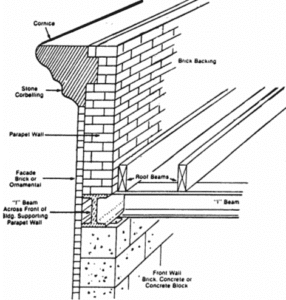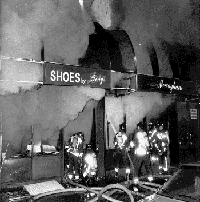MENU
Click on Menu to view additional Promotional Scenarios →
(Promotional Scenario 06)
While responding and operating at a fire in a 1-story Class 3/Ordinary Taxpayer, heavy fire exits out of one of the stores display windows. As an experienced and educated fire officer you know that if the fire is not quickly controlled, the fire will compromise the integrity of the parapet wall above.
Test question/challenge:
Identify the design defects and collapse concerns of a parapet wall.
Answer Key:
- Free-standing wall – The wall is only
 supported on one end; its base. The fact that a wall
supported on one end; its base. The fact that a wall
of any height is primarily being held up by gravity; has to be a concern. - Steel lintel support – As the scenario above describes, with heavy fire showing out of a large display window in a row of stores, fire will eventually affect the steel lintel that is supporting the parapet wall above the windows opening. Fire will force the steel to move/twist/bend eventually dropping the load it was intended to support.
- Unprotected steel – Our concerns could be further compounded from any steel found within the design of the brick and wood structure. Depending upon the stores square footage, steel may be found within a Class 3/Ordinary building to pick up the spans and associated loads of any wood members. A view of the diagram above actually shows a steel beam that is perpendicular to parapet wall. Note: Be aware of cracks that develop in the wall(s). This is a good indication that the steel within the building’s design is beginning to move.
- Attached signs/canopies and marques – If you review the first concern we listed, it
 would only make sense that any load that causes lateral forces on an unsupported wall has to be viewed as a significant concern. Firefighters have to exercise extreme caution when attempting to operate under or near any sign/canopy or marquee. Their failure can injury and kill firefighters.
would only make sense that any load that causes lateral forces on an unsupported wall has to be viewed as a significant concern. Firefighters have to exercise extreme caution when attempting to operate under or near any sign/canopy or marquee. Their failure can injury and kill firefighters. - Coping and cornice stones – On top of the parapet wall or mortared within its facade, will be a cornice or coping stone. Their design and placement on top of the parapet wall is not only for the aesthetics of the wall, but primarily to shed water off the top of the wall. Over the years, the mortar used to bond the stone to the top or facade of the wall will dry out and loose its bonding ability. What you will often find is that the coping stone is held in place by its own weight. Not only can you simply lift the stone off the wall, it can be easily knocked over by a ladder, hose stream, or firefighter.
- Steel reinforcement rods – This one is less obvious. Within the walls design there can be a series of steel reinforcement rods that are imbedded with the brick/block and mortar. They are often placed vertically, but more importantly, horizontally throughout the walls length. The steel placed within the walls design will undoubtedly strengthen the wall, but if any part of the wall is compromised it could bring down large sections of the wall over its entire length.
- Unfinished brick – When constructed and possibly over its tenure, building owners or tenants may have covered the front of the parapet wall with a glazing or finish that was intended to enhance the brick and mortar appearance. The coating not only added to the wall’s aesthetics, but it also served as a protective coating of the mortar limiting its erosion. This protective coating, as one would imagine, is not repeated on the backside of the parapet wall. From the owner or tenants perspective, this would be a waist of money and time. With all being said, expect that the back of a parapet wall will be more affected and compromised by the weather.
- Backdrafts – With any Class 3 designed building, members must anticipate fire spread and involvement of the cockloft space. The degree of involvement of the space will always be a concern to operating members. If involvement of the space produces a backdraft, the force of the backdraft cannot only blow ceilings down on top of firefighters; the pressure can also affect the integrity of the parapet wall.
Be Prepared!
